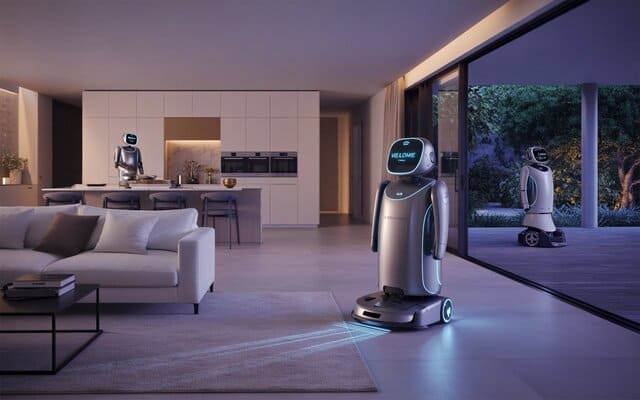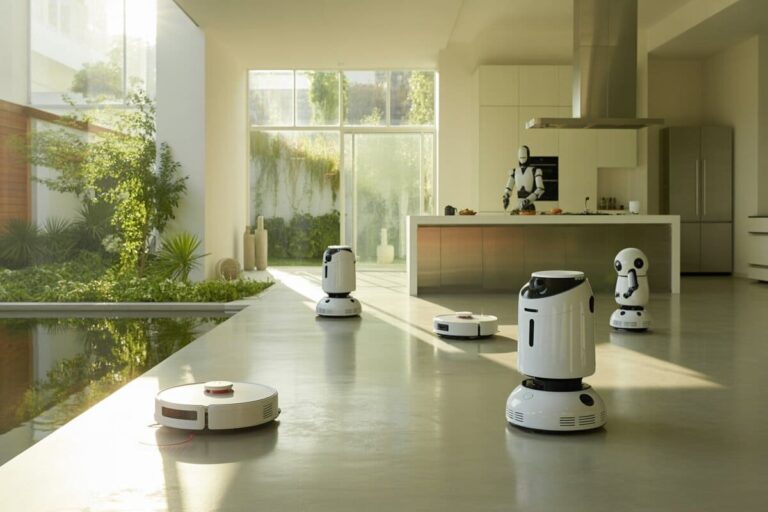Domestic robots are no longer just science fiction or luxury items for the wealthy.
With the rapid advancement of technology, automated devices are becoming an integral part of our homes, making daily tasks easier, enhancing security, and optimizing energy consumption.
Today, we’ll explore how this revolution is transforming households worldwide, the types of robots available, their benefits, challenges, and what to expect in the future.
What Are Domestic Robots?
Domestic robots are machines designed to perform specific tasks within a home. These devices use sensors, artificial intelligence (AI), and, in many cases, internet connectivity to operate efficiently and autonomously.
They go beyond simple tools; they are intelligent systems capable of learning and adapting to their environment.
The most common examples include robotic vacuum cleaners like the Roomba and home assistants such as Amazon Echo with Alexa. But the possibilities extend far beyond, encompassing kitchen robots, advanced security systems, and more.
Main Types of Domestic Robots
1. Vacuum and Floor Cleaners
Robots like the iRobot Roomba or Roborock use sensors to map the environment and automatically clean floors. Advanced models can even detect specific dirt spots and adjust their functions according to surface types.
2. Virtual Assistants and Voice Control
Devices like Google Nest, Amazon Echo, and Apple HomePod centralize the control of various household appliances. They also assist with daily tasks like setting reminders or adjusting the thermostat via voice commands.
3. Kitchen Robots
Machines like the Thermomix TM6 or CookingPal Multo automate cooking processes, such as chopping, mixing, and cooking ingredients, making meal preparation faster and more convenient.
4. Security Robots
Devices like the Ring Always Home Cam provide real-time surveillance, patrolling areas and sending alerts to your smartphone in case of suspicious activity.
5. Automated Gardening Systems
Devices like Tertill are designed for garden maintenance, such as trimming grass or removing weeds, using solar energy and intelligent algorithms.
Benefits of Home Automation with Domestic Robots
1. Time Savings
Domestic robots automate routine tasks like cleaning and maintenance, freeing up time for more important activities.
2. Energy Efficiency
Many smart devices monitor and optimize energy usage, reducing electricity costs.
3. Increased Security
Security robots offer constant monitoring and quick responses to intrusions or incidents.
4. Convenience and Personalization
Modern devices can be tailored to individual preferences, making homes more comfortable and practical.
5. Inclusivity and Accessibility
People with physical limitations or the elderly can significantly benefit from technologies that make daily tasks more manageable.
Challenges and Limitations
Despite their advantages, domestic robots face some obstacles:
- Initial Cost: Most devices still require a significant investment, especially advanced models.
- Privacy and Data Security: Since many robots are connected to the internet, there are concerns about the collection and misuse of personal data.
- Maintenance: Some devices require frequent maintenance or updates, which can be inconvenient.
- Technological Limitations: While AI is advancing, robots still struggle with complex or unexpected tasks.
Global Impact
The domestic robot revolution is not uniform worldwide. While developed countries such as Japan, the United States, and Germany lead in adoption, developing regions still face challenges related to costs and infrastructure.
However, the popularization of these technologies is encouraging the growth of startups focused on more accessible and adaptable solutions for various markets.
The Future of Domestic Robots

Home automation is just getting started. Here are some trends shaping the coming years:
- Full Device Integration: Robots will not operate in isolation but as part of a unified ecosystem managed by central AI systems.
- AI Advancements: Robots with advanced artificial intelligence will be able to predict needs and perform more complex tasks.
- Financial Accessibility: With technological advancements and mass production, the prices of domestic robots are expected to decrease, making them accessible to more people.
- Sustainability: New devices will be designed to consume less energy and produce less waste, aligning with environmental concerns.
- Multifunctional Robots: Devices that combine multiple functions into one will replace the need for several separate appliances.
Conclusion
Domestic robots are already transforming the way we live, bringing convenience, security, and efficiency into our homes. Despite the challenges, the future promises even more advanced and accessible technologies, making home automation a reality for everyone.
Whether cleaning floors, cooking meals, or safeguarding your home, robots are more than tools—they are partners that make daily life simpler and smarter. Are you ready to welcome the future into your home? 🚀




